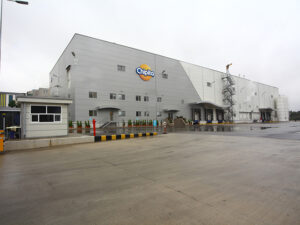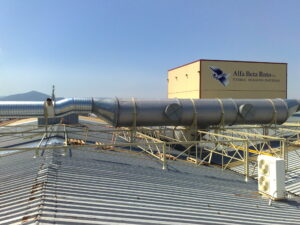
Chipita Russia – Industrial HVAC & Refrigeration
Confectionary & Sweets St. Petersburg, Russia 2015 Project scope was: Design & construction of the HVAC systems of the Chipita factory in St. Petersburg, Russia. Highlight The design & implementation
BCT company core expertise is the design and installation of HVAC and Refrigeration systems for Industrial Purposes.
CAPEX and OPEX optimization with respect to process requirements are the central goal which need to be achieved.
BCT integrates CIP self cleaning, UV sterilization and sanitating capabilities in hygiene AHUs for delicate food and bio-contamination applications.
Large facilities with multiple cooling consumptions and with different cooling load peaks present a challenging area and demand expertise approach. Energy consumption can vary significantly depending on the applied system (more than 60% of consumed energy can be saved in partial loads operation) as well as it is not assured that all areas requirements can be achieved as the system adjusts to the current demand.
Successful operation does not only follow to proper selection of cooling equipment, but the entire system must be properly designed.
Special consideration must be drawn to critical loads that shall be served under any circumstances therefore reserved capacity shall be assessed accordingly.
Cooling medium (water or glycol) flow adjustment of the circulated quantity according to demand is a key element which determines ability to effectively accommodate the current loads and consume the less possible energy.
Systems are designed appropriately to accommodate for peak and partial loads with the less possible energy consumption and best adjustment to load fluctuations.
Apart from the processes that require extra low humidity dehumidification is important in many HVAC applications especially in Cleanrooms and Contamination Control Spaces as humidity favors microbial growth.
Humidity is introduced also in a space by fresh air intake, common situation in cleanroom applications as fresh air is used for rooms pressurization and in 100% fresh air systems / 100% air exhaust systems.
There are numerous of practices to control humidity. All are highly energy consumers, and some require important CAPEX devotion, especially when desiccant dehumidification technology must be integrated.
Nevertheless, if good psychometric approach is developed from the beginning dehumidification costs can be maintained to a minimum. This can occur by treating fresh air dehumidification separately to the rest air of the system, by providing precooling to desiccant dehumidification processes, by incorporating face and by-pass technics.
Proper control of the system operation is very important in dehumidification systems. In BCT all control systems are designed and developed in-house by our automation experts.
System integrators using cooling and reheating to perform dehumidification are often mislead reacting to relative humidity variations without assessing water content level in the air. This leads to excessive energy consumption as system air is subjected to low temperature cooling below due point level and then reheating.
In BCT we have developed special algorithms to perform dehumidification only when water content calls for it and always in analog proportional way. We apply these algorithms even in the simpler application to provide the lowest energy consumption.
Return air by-pass is always our first choice to minimize reheating demands.
As low excessive humidity is detrimental for many manufacturing processes the same applies to low humidity content.
There are manufacturing processes where humidity must be maintained in a stable controlled level, such as Paper and Paper products industry, Printing Plants, Tabaco and wood industry.
Humidification is a delicate issue as it incorporates water or steam.
Water has a series of special parameters which need to be taken care of such as water treatment, salts that clog vaporization equipment and sanitation. On the other hand, steam requires also water treatment and is a high energy consumer. Both solution require effective maintenance and special care by the operators and service personnel.
In BCT we assess carefully every case to suggest the most appropriate solution taken into consideration the experience, capabilities and SOPs of the plant in terms of water treatment and steam equipment.
Pump station in HVAC-R systems are related to cooling or heating medium circulation to the manufacturing plant to feed equipment (HVAC, Refrigeration or Process).
Pumping equipment, especially in large scale production facilities, requires also careful design as it is a high energy consumer as well, it determines system effectiveness and in some times determines system success.
There are not less cases where we have seen inability of pumping volume adjustment proportionally to cooling / heating loads and consequently return water from inert cooling equipment to be mixed with chilled water and finally the mixture to be incapable of performing laten cooling and water condensation.
Pumping station design is always related to the piping circuit design and the way cooling / heating medium feeds consumptions. When two way analogue valves are used pump station can have variable water flow achieving substantial energy conservation. Special care must be drawn to variation limits in primary chillers water to assure unloading of the evaporators.
Pump station redundancy is important. Critical loads must always be satisfied even in the event of one pump malefaction.
For metal duct circuits construction, we follow SMACNA standards. Air distribution circuits are sized with respect to static regain technic or equal total pressure loss in all circuit branches.
Air leakages must be eliminated especially in cleanroom applications where air volume rates are highly necessary to be maintained.
In many cases Duct Circuits commissioning takes place and Pressurization Test.
Duct insulation is important for minimizing energy loss and temperature modification from what is controlled by the AHU but also in order to eliminate air condensation in the outer surface of the duct.
Use of black carbon steel piping is selected after assessement taking into consideration piping rusting overtime and potential heat exchangers clogging.
Piping circuits insulation is important aiming to minimize energy losses and condensation drainages. Pipping cladding especially in outdoor spaces is performed to protect insulation material by weather conditions deterioration.
Valves and special circuit devices, deaerators, vessels etc are part of the piping circuit and need to be carefully sized and incorporated in the system. In these we shall add axial pipe expansion joints to absorb pipe expansion and contraction as well as seismic expansion joints in positions where pipe is passing through building joints.
Piping supports, anchoring and pipes penetration to walls and roof are very important to assure proper static resistance, sustainability and building shell tightness in respect to water penetrations etc.
All piping circuits must undertake pressure test, deaeration and cleaning before operation.
In BCT Group we have a qualified team of experienced automation engineers who design the application’s automation system providing the most effective interaction of all parts of equipment. We develop our own automation systems simulating the Psychrometric & Cooling cycle Processes into HVAC-R Control Language.
In this way system is 365d/24h adapted to external conditions (ambient, fluctuation of internal load) in order to assure full compliance with the Requirements

Confectionary & Sweets St. Petersburg, Russia 2015 Project scope was: Design & construction of the HVAC systems of the Chipita factory in St. Petersburg, Russia. Highlight The design & implementation

Printing Industry Komotini, Greece 2012 Alfa Beta Roto produces flexible packaging materials for more than 50 years. They operate two production plants, one in Athens, and another in Komotini Greece.

Bakery Menidi, Greece 2011 Bakery products production plant in Menidi, Attica Greece Project overview: Leavening area low-temperature air conditioning 16o-18oC with humidity control Leavening area ventilation with supply of extra-filtered


An Engineering – Contracting & Validation Company, specialized in: Industrial HVAC Systems | Industrial Refrigeration | Cleanroom Design, Construction and Validation | Special Air Applications for Industrial Environments (Dry Applications, Degassing Systems etc)

Copyright 2024 © BCT – Group – All Rights Reserved.
Copyright 2022 © BCT – Group – All Rights Reserved.
Designed by Booms